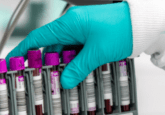New bead array technology could identify glycan biomarkers for disease

The highly sensitive Luminex Multiplex Glycan Array has been developed by researchers from the Medical College of Georgia at Augusta University (GA, USA) to establish glycans as biomarkers for a wide range of diseases.
The glycan coatings on cells have many functions, including providing adhesion, protection and recognition of the cell as being ‘self’. However, they are also implicated in many different diseases.
The beads in the new array are coated with 184 different glycans, enabling the simultaneous analysis of 384 samples of patient blood or serum. When the array is exposed to patient samples, any antibodies present will bind to their target glycans, permitting the link between glycans and the disease to be determined.
Researchers have already demonstrated the array’s success, as they have identified a potential biomarker for a higher risk of ovarian cancer relapse.
Jin-Xiong She, director of the Center for Biotechnology and Genomic Medicine at the Medical College of Georgia at Augusta University, explained: “This is really about predicting clinical outcome right after treatment for each patient.. What we want to do is to identify a biomarker that can separate the patients who have a poor versus good chance of survival.”
The team hopes that this technique will become a routine part of a patient’s medical checks, alongside blood testing for cholesterol or lipid levels, which can also be an early indication of disease. This will enable patients who are determined to have a high chance of relapse to be considered for a more aggressive therapy before disease relapse.
Sources: Purohit S, Li T, Guan W et al. Multiplex glycan bead array for high throughput and high content analyses of glycan binding proteins. Nat Commun. 9(1),258 (2018); www.eurekalert.org/pub_releases/2018-02/mcog-nte020918.php






